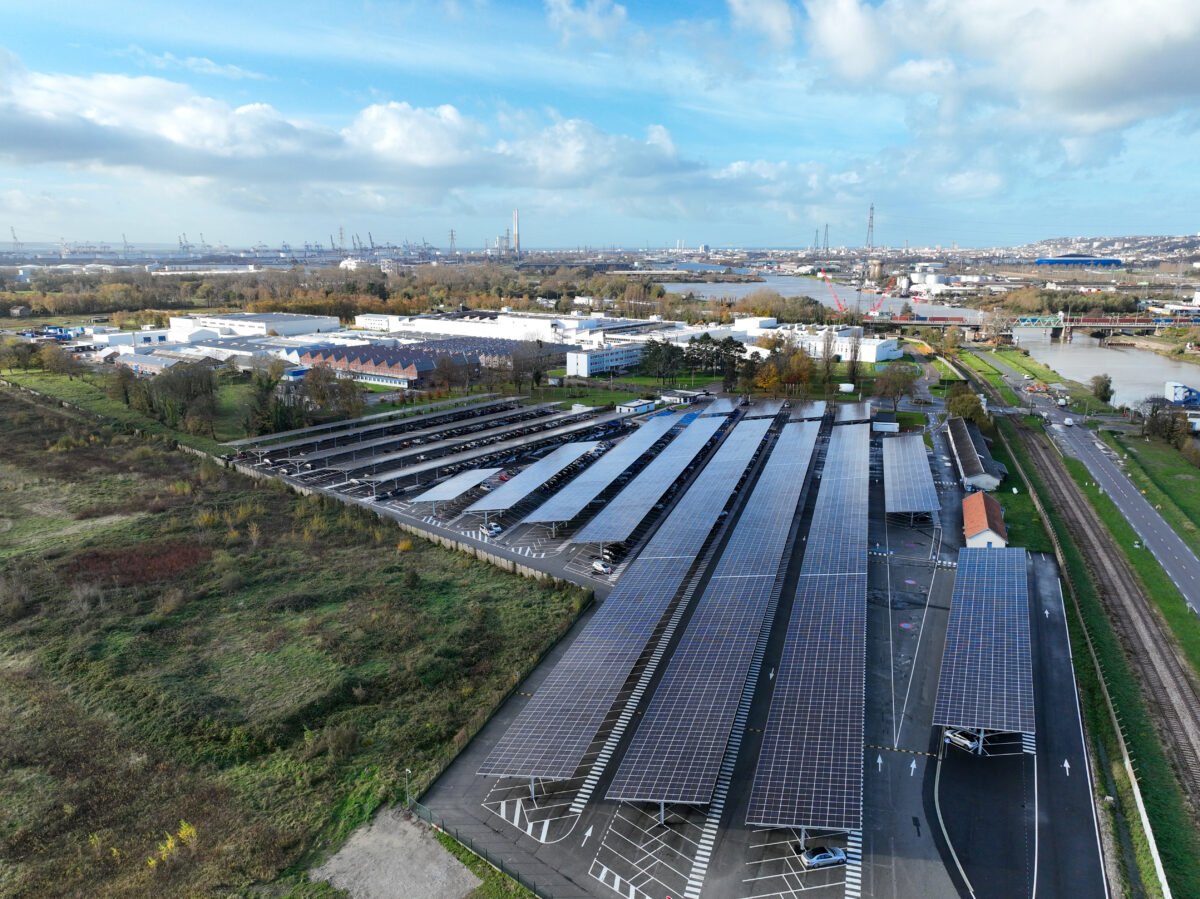The 4.8 MWp self-consumption power plant has been in operation since August 2023 and was built in less than twelve months. In an interview with pv France magazine, Ulysse Pierot, strategic projects manager at Reservoir Sun by GreenYellow, discusses in detail the challenge of this first collaboration with the French aviation group, especially in terms of safety and meeting deadlines.
What are the main characteristics of a solar power plant installed by Reservoir Sun by GreenYellow at the Safran-Nacelles manufacturing site in Gonfreville-l’Orcher
Ulysses Pierrot : It is one of the largest self-consumption photovoltaic power plants built on an industrial site in France. The project with a total output of 4.8 MWp consists of the installation of 12,000 photovoltaic panels of the Chinese brand DMEGC on parking screens on a total area of 24,000 m². It will cover more than 25% of the site’s energy needs with an annual production of 4.9 GWh of low-carbon electricity.
Image: Reservoir Sun
What is the genesis of the project with Safran?
Our first discussions date back just over four years. The French Aviation and Defense Group has launched discussions on decarbonisation in particular over solarization of its parking lots. However, the projects were not necessarily successful, the interest of photovoltaics was not sufficiently proven at the time, neither from a carbon nor from an economic point of view. The subject matured between 2019 and 2021 with the structuring of teams in Safran. The involvement of purchasing, “carbon” teams and various industrial sites led to the tender for the construction of photovoltaic power plants, which was won by Réservoir Sun in early 2022. It concerns 17 industrial sites, including Nacelles, the first one we worked on.
Why did you start the Nacelles site?
Above all, to fulfill her wish to be the first Safran subsidiary in France to have a photovoltaic power plant. Its president, Vincent Caro, wanted to move quickly and accelerate the movement on decarbonisation issues. Under his leadership, in-depth discussions took place between our teams leading to the contract in early July 2022.
What challenges did this first Safran experience present for Reservoir Sun?
Our biggest challenge was to complete this project in record time, less than a year between signing the contract and completing the work. On an operational level, the challenge was our ability to fit the various phases of the PV project into a tight twelve-month schedule. Before starting a project, there is usually a preparatory administrative and technical phase. Between the submission, the instruction and the deletion of the building permit – obtained in just 3 months thanks to the support of the Gonfreville-l’Orcher town hall – the DREAL (Regional Directorate for the Environment, Development and Housing) agreement was concluded, necessary in the case of an ICPE site (Installation classified as environmental protection environment), network detection, asbestos diagnostics, soil studies, etc., less than six months have passed in total.
Another challenge we faced was security. As a result of the bombing of the Nacelles site during World War II, much of the car park may have posed hazards, particularly during drilling for soil studies and the more so, at the time of establishment. To avoid this, we added a magnetic diagnosis to our preliminary studies without affecting the established plan. This subsoil mapping, carried out to a depth of 9 meters, allowed us to secure the site and ensure that there would be no problems with the 240 foundation piles. Finally, in order to maximize production, we had to reorient part of the car park with all the challenges this entails in terms of foundations, posts, routing, etc. and its free and safe access for Safran employees during work.
What measures have you put in place to deliver on time?
The project involved 3 to 4 fully dedicated people at Reservoir Sun. But putting the plant into operation in such a short time would not have been possible without the investments of the Safran teams. The latter greatly contributed to the success of the project, especially General Resources, with whom we worked closely and coordinated perfectly step by step. Every week we discussed all the technical points and found a solution: what to do with the trees on site? Where to place substations and cable passages? How can we anticipate the installation of future electric car terminals and thus avoid too frequent damage to the parking lot?
At the beginning of the project, in the middle of February 2023, and based on all these forecasts, we simply had to “launch” the previously verified phases with our statics and electricians in a standard way: creating the foundation, drying the phase, mounting structure, installing modules and electrical connections. Even the days of delay caused by the blockade of the industrial zone during the strikes against the pension reform could be made up.
What are your future projects with Safran?
Other projects still involve the Safran-Nacelles subsidiary, but in two locations that did not appear at the start of the global tender: Florange and Pont-Audemer, near Le Havre, where work will start in 2024 under much less pressure. “conditions. Aircraft Engines subsidiaries in Ile-de-France will follow in Evry-Corbeille, Villaroche and Gennevilliers.
This content is copyrighted and you may not reuse it without permission. If you would like to collaborate with us and reuse our content, please contact our editorial team at the following address: editors@pv-magazine.com.

